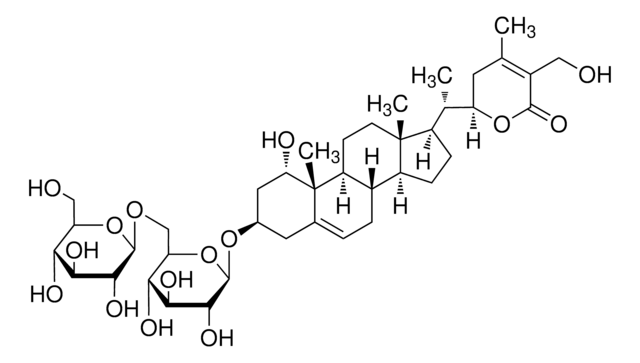41719
(3S)-2,3-Oxidosqualene
≥97.5% (HPLC)
Synonym(s):
(S)-2,3-Epoxy-2,3-dihydrosqualene, (S)-22,23-Epoxy-2,6,10,15,19,23-hexamethyl-2,6,10,14,18-tetracosapentaene, (S)-Squalene 2,3-epoxide, (S)-Squalene 2,3-oxide
About This Item
Recommended Products
Assay
≥97.5% (HPLC)
form
liquid
optical purity
enantiomeric excess: ≥90.0%
suitability
conforms to structure for Proton NMR spectrum
storage temp.
−20°C
SMILES string
CC1(C)O[C@H]1CC/C(C)=C/CC/C(C)=C/CC/C=C(C)/CC/C=C(C)/CCC=C(C)C
InChI
1S/C30H50O/c1-24(2)14-11-17-27(5)20-12-18-25(3)15-9-10-16-26(4)19-13-21-28(6)22-23-29-30(7,8)31-29/h14-16,20-21,29H,9-13,17-19,22-23H2,1-8H3/b25-15+,26-16+,27-20+,28-21+/t29-/m0/s1
InChI key
QYIMSPSDBYKPPY-RSKUXYSASA-N
Application
- Schizophrenic behavior of 2,3-Oxidosqualene Sterol Cyclase from pig liver towards 2,3-oxidosqualene analogues. Alain Krief and colleagues discuss the variable catalytic behaviors of oxidosqualene cyclase when interacting with different oxidosqualene analogues, suggesting implications for sterol production efficiency and specificity (Krief et al., 2021).
Biochem/physiol Actions
Storage Class Code
10 - Combustible liquids
WGK
WGK 3
Flash Point(F)
Not applicable
Flash Point(C)
Not applicable
Certificates of Analysis (COA)
Search for Certificates of Analysis (COA) by entering the products Lot/Batch Number. Lot and Batch Numbers can be found on a product’s label following the words ‘Lot’ or ‘Batch’.
Already Own This Product?
Find documentation for the products that you have recently purchased in the Document Library.
Customers Also Viewed
Our team of scientists has experience in all areas of research including Life Science, Material Science, Chemical Synthesis, Chromatography, Analytical and many others.
Contact Technical Service







